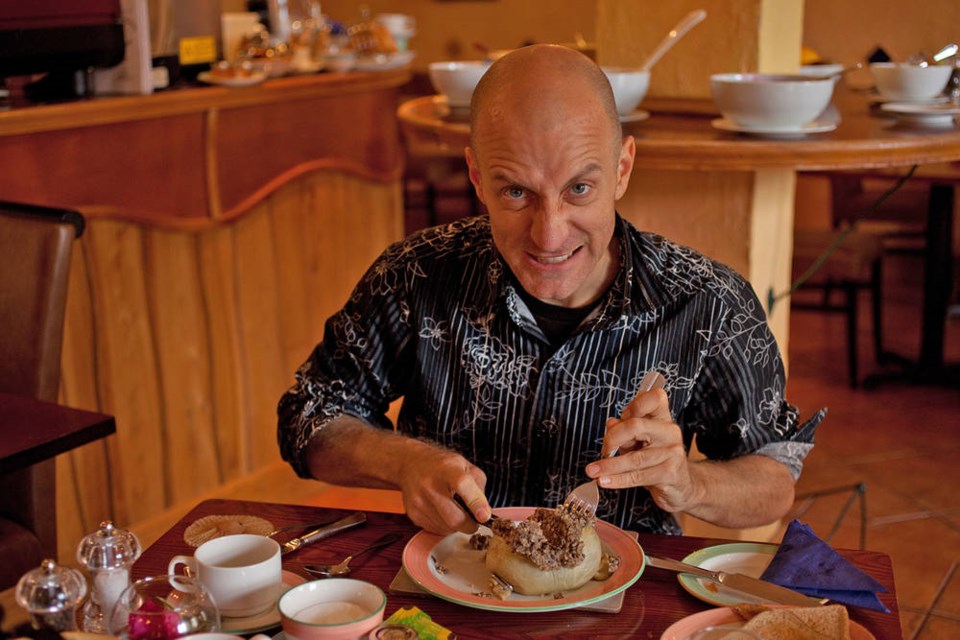As we’ve had to postpone our travels because of the pandemic, I believe a weekly dose of travel dreaming can be good medicine. Here’s a reminder of the fun that awaits us in Europe at the other end of this crisis.
My palate has come a long way from my early “Europe through the gutter” days, back when my travel diet consisted of cheap baguettes spread with peanut butter and strawberry jam packed from home. Now one of my favorite parts of travel is sampling local specialties. And I do it with abandon. From pigs’ ears in Spain to horsemeat in France and spicy sheep intestines in Turkey, I make it a point to try dishes that make a menu unique — no matter how unappetizing they sound. Think of it as sightseeing for your palate.
How much you enjoy the experience depends on your attitude. “Weird” is subjective. Countries with a seafaring heritage, like the Dutch, embrace herring as a vitamin-rich food. Pickled herring is considered a classic. Having tasted this delicacy, I can say it’s something you won’t soon forget (no matter how hard you try).
I still remember the first time I tried pickled herring in the town of Haarlem. It was on market day at a herring stand — the Dutch version of a hot-dog stand — with a big sign that advertised “lecker en gezond” (delicious and healthy). The fish looked more like bait than lunch. Sensing my hesitation, Jos, the friendly herring vendor, demonstrated how to eat it. “I give you the herring Rotterdam-style. You eat it like this,” he said, miming swallowing a sword. “If I chop it up and give you these,” he said, pointing to the toothpicks “this is Amsterdam-style.” After my first bite, the only polite comment I could muster was, “It’s salty.” But the taste grew on me. As I wandered through the market, taking Amsterdam-style bites of my Rotterdam-style herring, I felt a fishy kinship with the Dutch. As I passed his herring stand again a few minutes later, Jos hollered, “Lecker?” I responded, “En gezond!”
Most Scandinavian nations have one seafood dish that, while inedible to many people, is still cherished with a perverse but patriotic sentimentality. In Norway that’s lutefisk — dried cod marinated for days in lye and water. My theory is that it’s still served today to remind young Norwegians of their ancestors’ suffering.
Local specialties often come from a challenging history and then become tradition. Roman cooking didn’t originate in the kitchens of emperors or popes, but from the cucina povera — the home-cooking of the poor, common people. This may explain the Romans’ fondness for meats the wealthy didn’t bother eating. Known as the quinto quarto (fifth quarter), these were pieces like tripe, tails, brains, and pigs’ feet.
Scotland’s national dish, haggis, also began as peasant food. Unwilling to let any part of a sheep go to waste, cooks would create a hearty meal by boiling scraps of heart, liver, and lungs with herbs in stomach lining. The trick to appreciating such dishes is to think of how they taste, not what they’re made of. Just like with caviar, hot dogs…or foie gras.
Foie gras is one of France’s most expensive indulgences. Because it’s made from fattening the livers of geese through force-feeding, it has attracted controversy. The dish is most popular in the Dordogne region, where ages ago, locals caught geese on their migration — and found the goose livers were enlarged for the long journey (like traveling with a topped-off gas tank). And you know those French: Mix those innards into the cuisine and create a new taste treat.
Speaking of innards, Turks are serious about their kokoreç: chopped-up sheep intestines, often served on a sandwich as fast food. Several years ago, a rumor flew through the streets that stringent new European Union regulations would outlaw the beloved dish. Before the story was debunked, many Turks did some soul-searching and decided that if they had to choose, they’d gladly pass up EU membership for their kokoreç.
Wherever I go, I find the food that inspires such nationalism is worth a try. Eating these unusual dishes — from Iberia’s percebes (barnacles) to Venice’s seppia (squid served in its own ink) to Norway’s geitost (goat cheese that resembles earwax) — not only helps me feel like a temporary local, but also gets me treated like one.
Until we’re all able to travel again, I hope your time at home is both “lecker en gezond.”
This article was adapted from Rick’s new book, For the Love of Europe.
Rick Steves () writes European guidebooks, hosts travel shows on public TV and radio, and organizes European tours. You can email Rick at [email protected] and follow his blog on Facebook.


